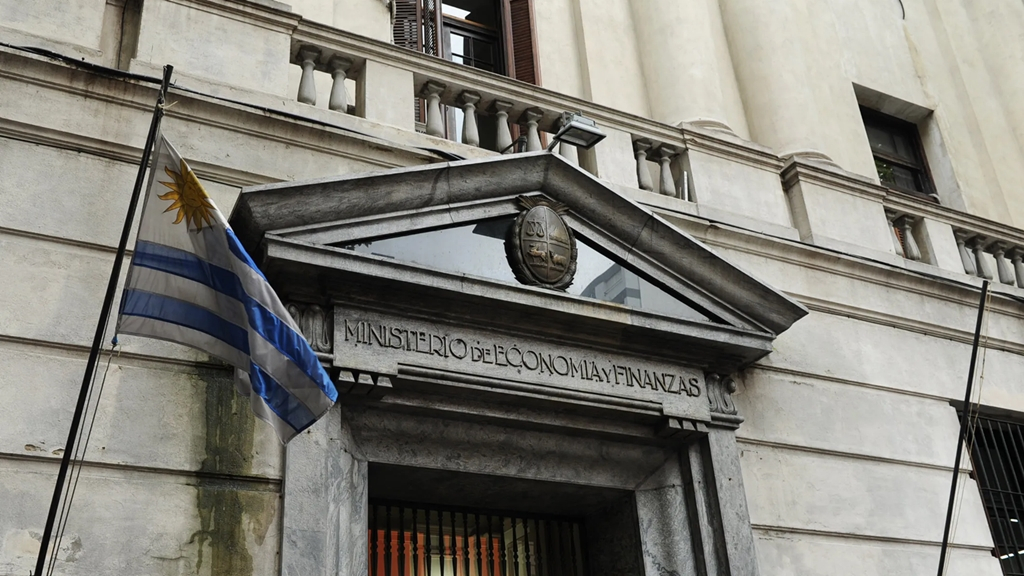
La calificadora mantuvo el grado inversor del país pero revisó a "negativa" la perspectiva
Declaración original en inglés:
Fitch Ratings-New York-05 October 2018: Fitch Ratings has affirmed Uruguay’s Long-Term, Foreign-Currency Issuer Default Rating (IDR) at ‘BBB-‘ and revised the Rating Outlook to Negative from Stable.
A full list of rating actions is at the end of this rating action commentary.
KEY RATING DRIVERS
The revision of Uruguay’s Outlook to Negative reflects persistent fiscal deficits and a high and rising debt burden that are eroding policy space to confront shocks, against a backdrop of tightening global financing conditions and a challenging macroeconomic environment in the region. Uruguay has seen one of the largest increases in government debt-to-GDP in the ‘BBB’ category since 2013 when it reached investment grade. Fitch believes the likelihood of fiscal adjustment measures is low in the forecast period through 2020, given that it includes an election cycle. Fitch expects the economy to remain broadly resilient to economic turbulence in the region. Nevertheless, growth has been weak relative to ‘BBB’ peers in recent years and is projected to further underperform, and regional headwinds could pose additional downside.
Uruguay’s ratings are supported by strong structural features in terms of social and institutional development, high external liquidity and a net external creditor position, and long-dated public debt and liquidity buffers mitigating financing risks. These factors are balanced by weak public finances, reflecting spending rigidities and a poor track record in meeting fiscal targets, a relatively large stock of foreign-currency debt, and persistently high inflation.
Uruguay’s economy is slowing, as the cyclical drivers of a moderate 2.7% recovery in 2017 have worn off and new headwinds have emerged. A real wage slowdown following an inflation rebound and weak consumer confidence are weighing on consumption, while net exports face headwinds from a drought affecting agriculturaloutput and loss in exchange rate competitiveness relative to neighbors. Fixed investment could be bottoming out after a 25% cumulative real contraction since 2014, but does not yet appear on track for a firm recovery. A trend of net job losses since 2014 reflects a challenging economic backdrop.
Fitch projects real GDP growth will fall to 2.0% in 2018 and 1.5% in 2019, although downside risks remain. This slowdown is more pronounced net of base effects from the reopening of an oil refinery in 2018 and an outsized contribution from the telecom sector in current GDP series (growth of 2.4% yoy in the first half of 2018 was around 0.5% net of these effects). Fitch’s projections also incorporate a moderate negative impact from Argentina’s nascent recession and currency crisis, which will affect Uruguay primarily via tourism flows. Direct financial linkages between the countries are narrow, however, and Uruguay’s banking system remains sound.
Fitch expects construction of a large pulp plant to provide a significant boost to the investment and growth outlook as soon as 2020. Investment prospects beyond this megaproject appear constrained, however, as evidenced by a low investment rate of 16% and a business climate that ranks poorly compared with peers in global surveys. The government has revamped a tax incentives regime and taken other steps to encourage investment, but has limited scope for major reforms given fiscal constraints and limited political appetite ahead of 2019 elections.
Inflation stood at 8.3% in September, having risen further above the 7% upper limit of the official target (5%+/-2pp) in 2018 as favorable base effects have worn off. Core inflation and expectations are also back above target. The central bank (BCU) officially maintains a contractionary policy stance but has not tightened it despite the inflation rebound, reflecting constraints from weak transmission channels and policy trade-offs given a peso that remains strong despite recent depreciation (30% above its 2008-2017 average in real effective terms as of August).
Above-target inflation has posed a difficult backdrop for a major round of wage negotiations in the private sector. Some negotiations have been protracted, and others have reached agreements but defied some elements of executive guidelines aimed at reducing the size and frequency of backward-looking inflation adjustments that add inertia to inflation dynamics.
Public finances have begun to deteriorate again in 2018, after an improvement in 2017 due to adjustment measures. The central government deficit stood at 3.0% of GDP in the twelve months through August, in line with 3.0% in 2017, but reflecting an underlying deterioration net of a 0.35pp one-off revenue transfer from an energy stabilization fund. The public sector deficit targeted in the budget rose to 3.9% in August from 3.5% in 2017, encompassing the flat central government deficit and higher deficits among public utilities and the BCU.
Fitch projects that the central government deficit will rise to 3.1% of GDP in 2018 and 3.6% in 2019, and that the public sector deficit will also rise instead of falling toward the government’s 2019 target of 2.8% (recently hiked from 2.5%). A growth-driven revenue boost expected by the government is unlikely in Fitch’s view in light of a flat revenue trend seen so far in 2018, and a weakening economic outlook tilting revenue-side risks to the downside. Primary spending has also overshot official projections repeatedly in the past, and appears to be doing so again so far in 2018 as both entitlement and discretionary expenditure are inching upward rather than stabilizing as the government expects. Interest costs are set to rise on peso depreciation.
Fitch believes a clearer fiscal consolidation strategy could emerge after general elections in late 2019, but that it will be challenged by limited appetite for further tax hikes and a highly rigid spending profile. There is growing discussion around social security reform, as demographics and reforms over the past decade (including a 2017 law allowing persons near retirement to exit the private pillar) have added long-term pressures on public finances. The current government is close to approving a reform of military pensions, which could help alleviate fiscal pressures beyond Fitch’s forecast period.
Fitch projects general government debt will jump to 62.7% of GDP in 2018 from 57.7% in 2017 (or to 53.5% from 48.8% excluding recapitalization bonds held by the BCU), and rise further in the following years above the current ‘BBB’ median of 39% The jump in debt metrics in 2018 reflects high sensitivity to the exchange rate due to large stock of FC-denominated debt (28% of GDP as of June, or almost half of the debt stock), following two years in which real peso appreciation flattened debt metrics. Proactive debt management efforts significantly mitigate financing risks. Near-term maturities are low, and liquid assets and contingent credit lines cover debt service needs through 2019.
Sound external finances help mitigate vulnerabilities to external headwinds, in the absence of meaningful counter-cyclical fiscal and monetary policy space. Fitch projects Uruguay’s small current account surplus will turn into a moderate deficit in the forecast period as construction of the pulp plant ramps up, but should remain financed by corresponding FDI inflows. Uruguay’s balanced current account position reflects a private sector is little reliant on external funding balancing a sovereign that remains a net external borrower. The sovereign, banks and corporates maintain healthy FX liquidity positions. External financing needs are low and are amply covered by a large stock of central bank FX reserves, even after recent FX interventions.
SOVEREIGN RATING MODEL (SRM) and QUALITATIVE OVERLAY (QO)
Fitch’s proprietary SRM assigns Uruguay a score equivalent to a rating of ‘BBB+’ on the Long-Term, Foreign-Currency (LT FC) IDR scale.
Fitch’s sovereign rating committee adjusted the output from the SRM to arrive at the final LT FC IDR by applying its QO, relative to rated peers, as follows:
–Macro: -1 notch, to reflect a relatively poor track record of compliance with inflation and fiscal targets, which weighs on policy credibility and narrows counter-cyclical policy scope.
–Public Finances: -1 notch, to reflect a highly rigid expenditure profile dominated by heavily indexed and constitutionally protected social entitlements, with a low share of capital spending. This poses challenges to fiscal consolidation goals. A large stock of foreign-currency debt makes Uruguay’s debt metrics particularly sensitive to exchange-rate risk.
Fitch’s SRM is the agency’s proprietary multiple regression rating model that employs 18 variables based on three-year centered averages, including one year of forecasts, to produce a score equivalent to a LT FC IDR. Fitch’s QO is a forward-looking qualitative framework designed to allow for adjustment to the SRM output to assign the final rating, reflecting factors within Fitch’s criteria that are not fully quantifiable and/or not fully reflected in the SRM.
RATING SENSITIVITIES
The main risk factors that, individually or collectively, could trigger a downgrade are:
–Failure to reduce fiscal deficits and/or improve the trajectory of government debt metrics;
–Further economic underperformance relative to peers;
–Erosion of external liquidity buffers.
The Rating Outlook is Negative. Consequently, Fitch does not currently anticipate developments with a high likelihood of leading to a positive rating change. However, the main factors that, individually or collectively, could lead to a stabilization of the Outlook are:
–Greater confidence in a fiscal consolidation path that would support stabilization of debt metrics in the medium term and/or further de-dollarization of the debt stock;
–A sustained reduction in inflation and better anchoring of inflation expectations;
–Evidence of investments or productivity gains that lift medium-term growth prospects.
KEY ASSUMPTIONS
–Fitch assumes that construction of a new pulp mill project will begin as soon as 2020, and related infrastructure before then, supporting growth during the construction phase and once production begins;
–Fitch projects Argentina’s economy will contract -2.5% in 2018 and remain flat in 2019, and that Brazil’s economy will grow 1.3% in 2018 and 2.2% in 2019.
The full list of rating actions is as follows:
–Long-Term, Foreign-Currency IDR affirmed at ‘BBB-‘; Outlook Negative;
–Long-Term, Local-Currency IDR affirmed at ‘BBB-‘; Outlook Negative;
–Short-Term, Foreign-Currency IDR affirmed at ‘F3’;
–Short-Term, Local-Currency IDR affirmed at ‘F3’;
–Country Ceiling affirmed at ‘BBB+’;
–Issue ratings on long-term senior unsecured foreign-currency bonds affirmed at ‘BBB-‘;
–Issue ratings on long-term senior unsecured local-currency bonds affirmed at ‘BBB-‘.
Contact:
Primary Analyst
Todd Martinez
Director
+1-212-908-0897
Fitch Ratings, Inc.
33 Whitehall Street
New York, NY 10004
Secondary Analyst
Daniel Pulido-Mendez
Analyst
+1-212-908-0586
Committee Chairperson
Shelly Shetty
Senior Director
+1-212-908-0324
Media Relations: Elizabeth Fogerty, New York, Tel: +1 212 908 0526, Email: [email protected]
Additional information is available on www.fitchratings.com


























